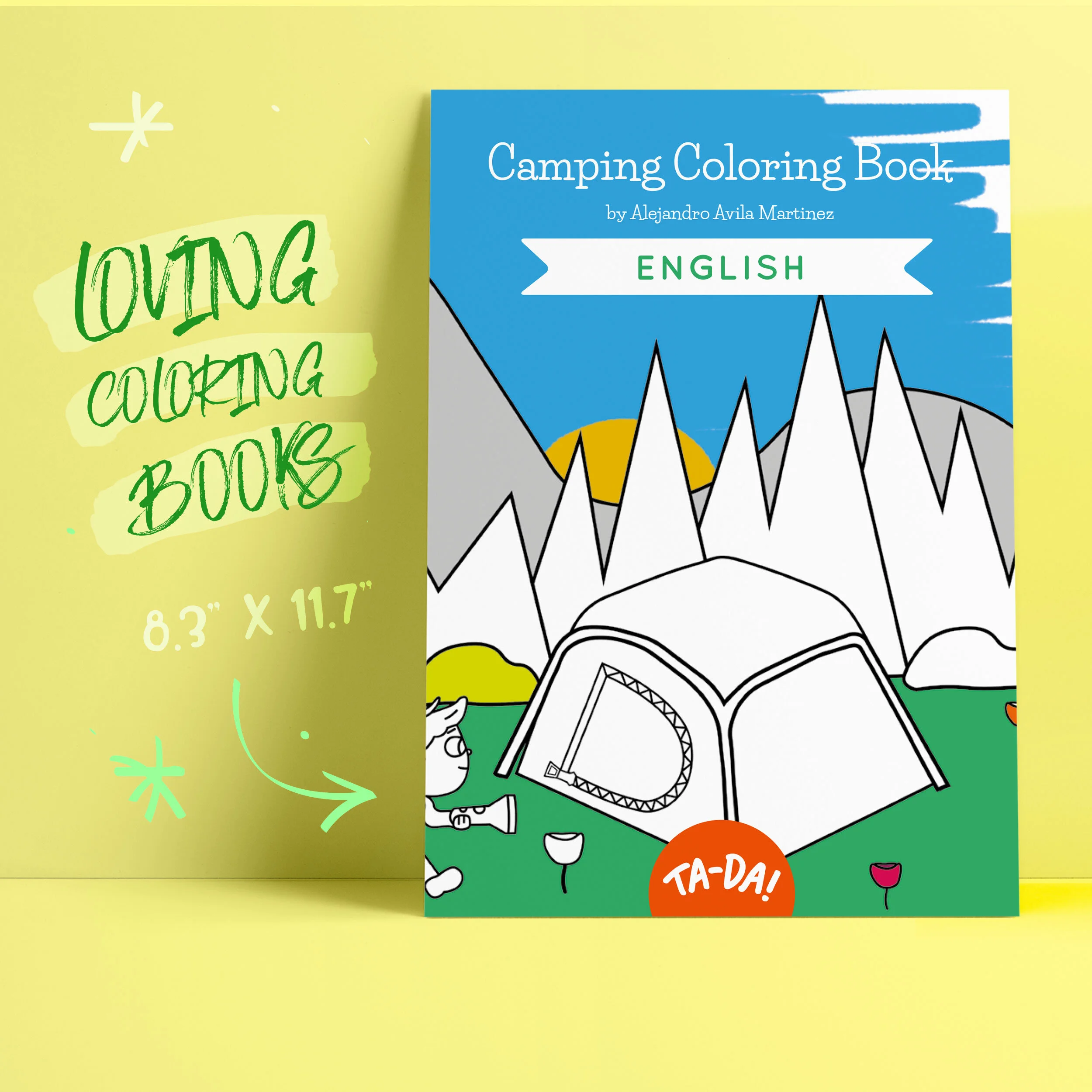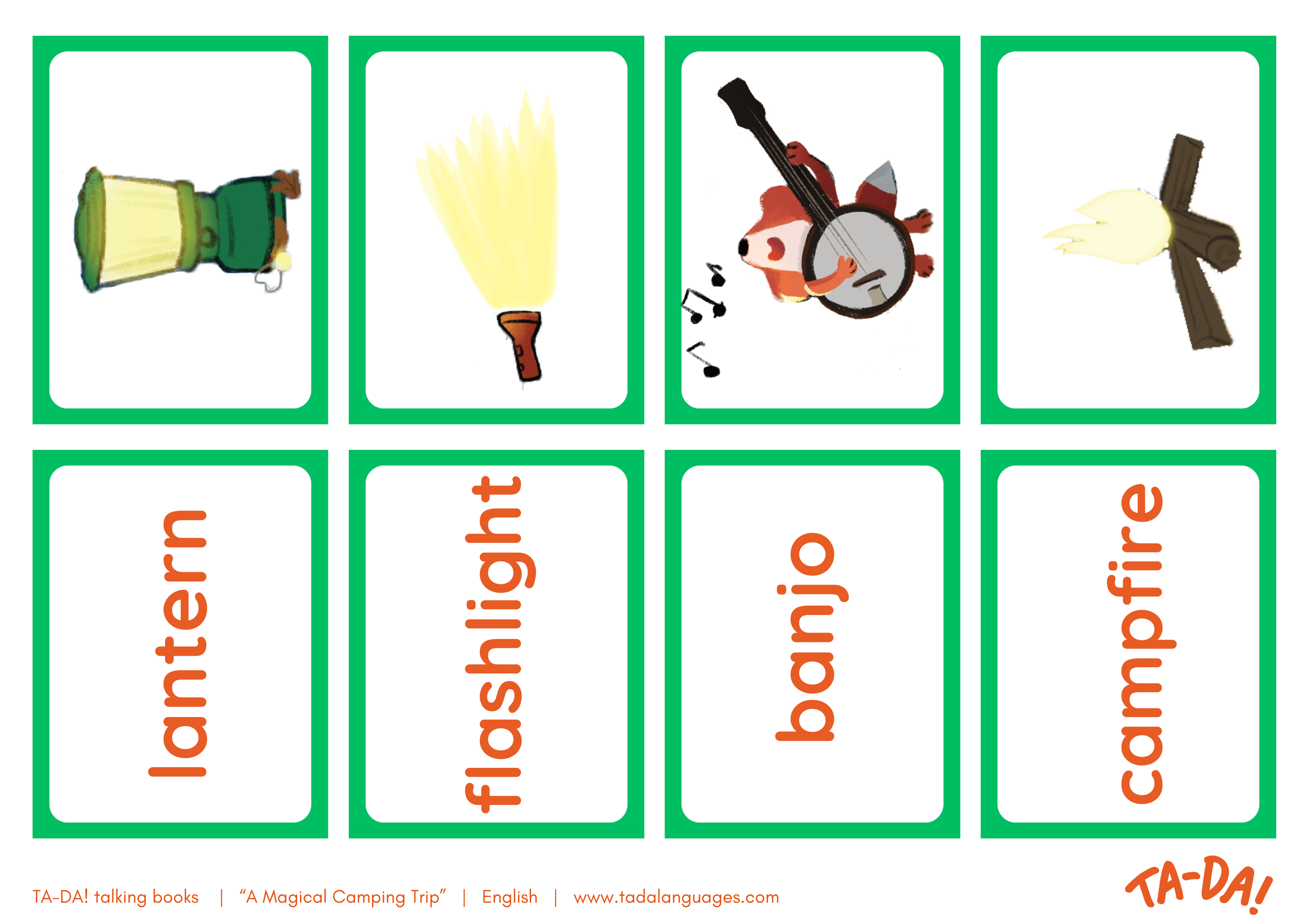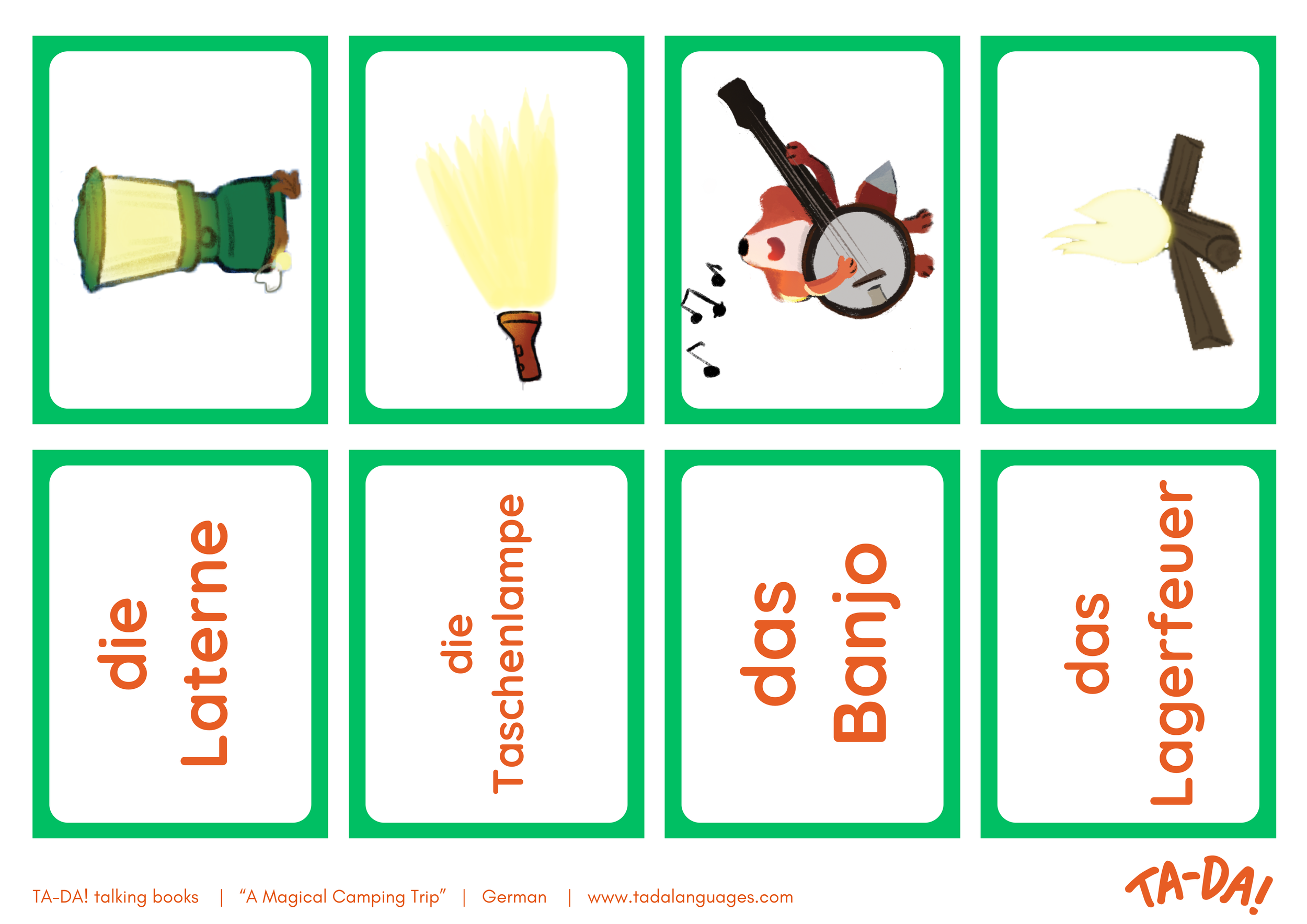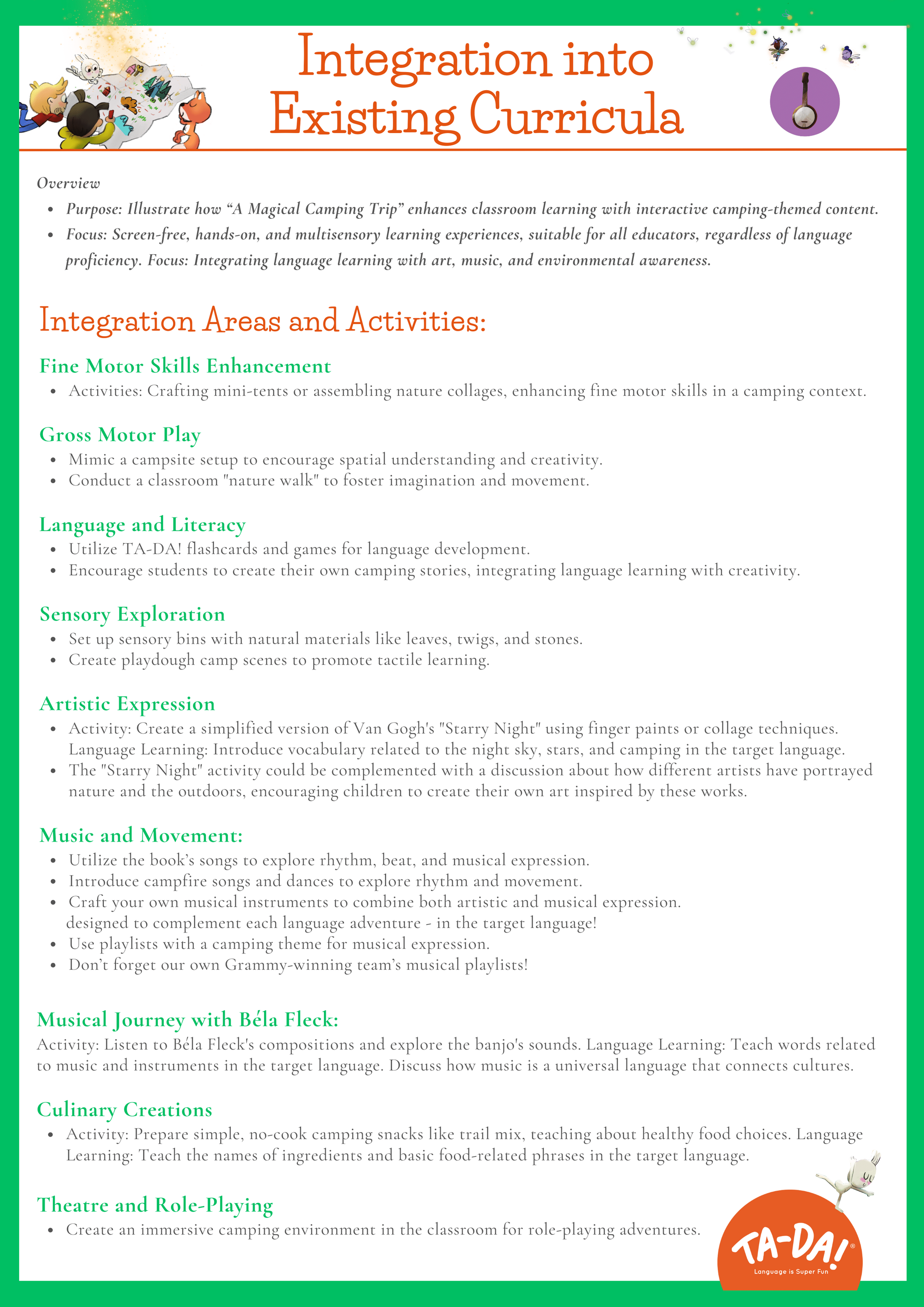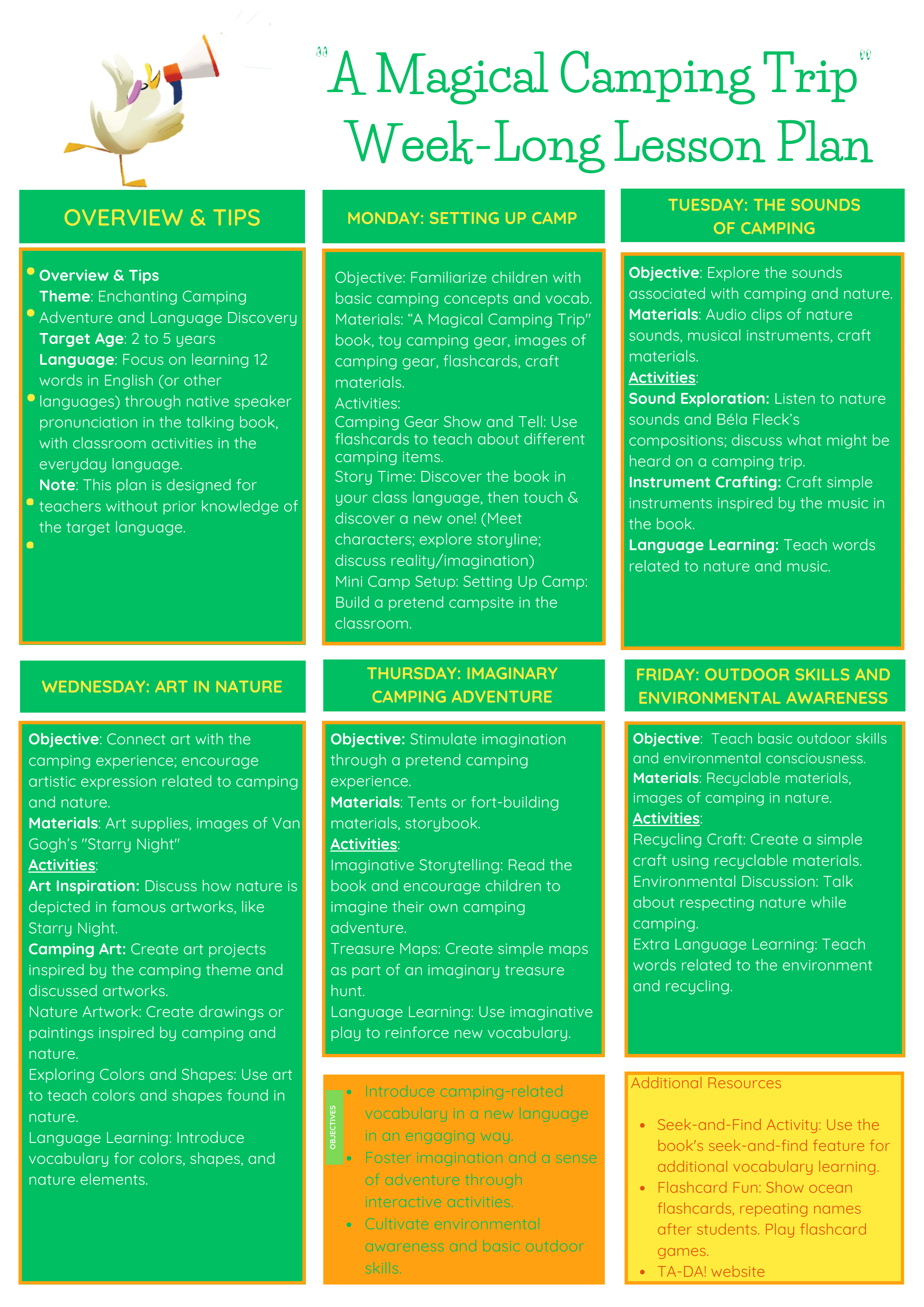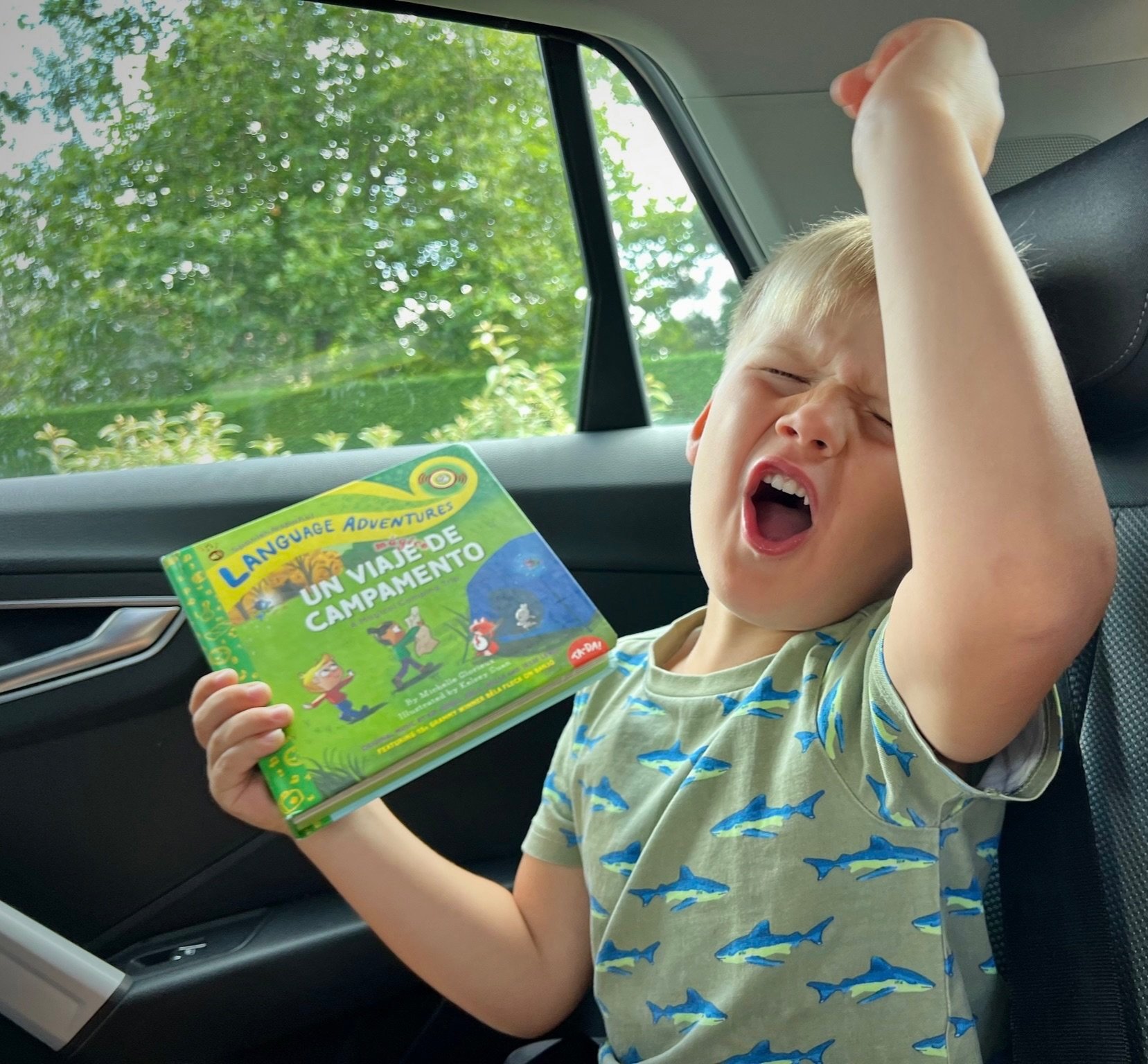
Language Learning Never Felt So GOOD with 15x Grammy winner Béla Fleck!




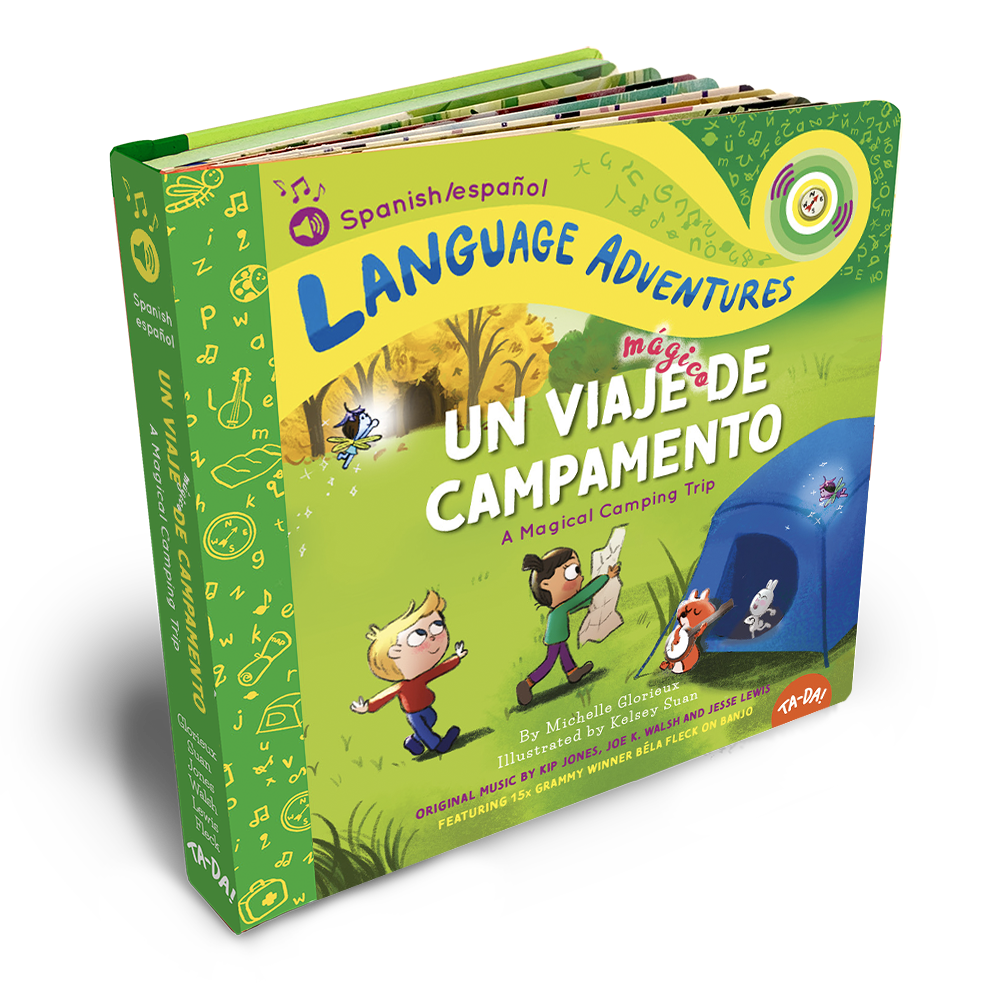
Magical & Musical
Early Literacy Adventures for ages 0-5+
Available in English, Spanish, German, French and Mandarin
Introducing TA-DA! talking and musical books—where all it takes is a finger’s touch to a beautiful, eco-friendly book’s pages to bring 12 vocabulary words pronounced by native speaking kids from our partnering schools — and original music to life!
Features of the Camping Language Adventures title:
26 colorful pages by the artist of “Hair Love” Oscar fame, 12 original songs featuring original music by 15x Grammy-winning sensation Béla Fleck, produced by the 4x Grammy award-winning producer of Yo-Yo Ma!
Extra, Extra-Special Guest Star:
Béla’s son Juno makes a special appearance in the English title, pronouncing one of the 12 words. Can you guess which one?
Two neighbors—and their bunny and fox friends—set out on a camping adventure. Are they sleeping under the stars in their backyards…or have fairy guides led them to an enchanted forest?
Let your little one make the call - empowering, creating a bonding experience in your loving embrace, creating book lovers - and creating positive associations with language learning that will last FOREVER.

WHY MUSIC?
Music is our first language, the universal language - and the natural conduit for children’s language learning!
Just Click
Banjo Crafting with
Béla Fleck!
3D PAPER CRAFTING
Expert Tips:
Fine Motor Skills: Encourage children to participate in cutting out the images (with safety scissors and adult supervision) and folding the paper. This can help develop their fine motor skills and hand-eye coordination.
Environmental Storytelling: After crafting the scenes, children can use the 3D paper figures to act out stories from their Talking Books, or they can create their own, fostering both creativity and language skills.
Cultural Exploration: Incorporate fun facts about the instruments’ or objects' origins, their roles in their native ecosystems, or their significance in various cultures to spark curiosity and cultural appreciation.
Color and Design: Let children choose their color schemes and decorations to express their individual styles. Encourage them to draw additional elements or background details related to each theme.
Puppet Play: Turn the paper figures into puppets by attaching them to sticks or straws. Children can use them to put on a play, encouraging expressive language use and storytelling.
Articulation Practice: Use the paper scenes to practice pronunciation of tricky words from the Talking Books. Repetition through play is a fun way to perfect new sounds.
Interactive Display: Set up a space where the children can display their crafted scenes. It can be a 'museum' where they give tours, using vocabulary from the Talking Books to describe their exhibits.
Remember, the key to these paper crafting activities is not just in the making and playing but in the opportunities they present for language immersion, cultural exploration, and creative expression. Through these imaginative plays and crafting sessions, children aren't just learning new words; they're experiencing the joy of bringing a language to life through art and play. It's this positive, hands-on approach that will leave a lasting impression on young learners, fostering a deep love for languages and cultures.
MEMORY GAMES
Expert Tips/Suggestions:
Guided Imagery Relaxation: Before starting the game, have the children close their eyes while you describe one of the themed environments in detail. For instance, describe the sounds and sights of a campsite, or the smell of the forest while camping. This can relax children and get them excited about the game, enhancing their focus and memory retention.
Personalized Backdrops: Encourage children to draw or color a thematic scene on a large piece of paper where they can place the cards for the game. A zoo scene with cages and trees, an underwater seascape, or a campsite can make the game more engaging.
DIY Card Holders: Guide children to create their own card holders with themed decorations. For instance, they could make a simple stand with banjos or trees.
Mix and Match with Realia: Integrate real objects related to the themes with the cards. For example, include a small stuffed animal for the zoo theme, a shell for the ocean theme, or a mini flashlight for camping. After finding a match, children can pair the card with the object.
Flashlight Fun: Turn off the lights and play the memory game using a flashlight to find and illuminate the cards. This can be especially fun with the camping theme, mimicking a nighttime adventure.
Card Scavenger Hunt: Hide the cards around the room and have the children find one, then return to the main playing area to find its match among a laid-out set of cards.
Themed Snacks: Incorporate snacks that align with the theme to enjoy after gameplay. Animal crackers for the zoo, goldfish crackers for the ocean, and s'mores for camping could be fun.
Storytime Integration: Pair the memory game with storytime, where each matched pair of cards leads to a page or passage in a story that connects with the theme.
Themed Music: Play thematic music in the background while playing the game. Animal sounds or jungle music for the zoo, ocean waves or aquatic music for the ocean, and nature sounds or campfire songs for camping can enrich the experience.
Puzzle Piece Rewards: Each time a child makes a match, they earn a piece of a puzzle related to the theme. Completing the puzzle can be a goal that complements the memory game.
Deeper Dive, Language Learning: For bilingual households or classrooms, use the target language to describe the pictures on the cards. This can reinforce new vocabulary and language skills while playing the game.
Positive Reinforcement: Offer praise for effort, not just for finding a pair, to encourage a positive learning environment. Use phrases like “Great try!” or “You're remembering well!”
Along with these engaging activities, it's key to remember that exposure to language should be a delightful experience. Whether the memory game is played in the target language or the native language of the child, the focus should be on the joy of learning and the excitement of discovery. The use of their native language ensures that children are comfortable and supported while also being introduced to the new language in a stress-free way. By providing a gentle introduction to language, these memory games will not only help children learn new words but also create fond memories associated with the language learning process.
FLASHCARD SET
Expert Tips/Suggestions:
Match and Move: To add a physical element, have the child perform a simple action related to the card. For example, strum a banjo or pretend to roast a marshmallow.
Tactile Cards: Enhance flashcards by adding textures. Stick on small branches or slivers of wood; or a piece of tent-like material for camping-related words. It’s a tactile way to connect the word to the real world.
Themed Sounds: Encourage children to imitate the sound with the object when they see the card. This auditory association helps cement the word in their memory.
Storytelling: Use the flashcard as a prompt to tell a short story or share an interesting fact. "Did you know banjos originated in Africa?" This method turns a simple word recognition exercise into a language-rich storytelling session.
Memory Rhymes: Invent catchy rhymes that describe the flashcard’s image or create a fun story about it. "Pluck, pluck, pluck the strings,
Hear the banjo as it sings!”Use Thematic Props: Pair the flashcard with a related prop. Hold a real or toy banjo while teaching the word "banjo”. It’s an engaging way to enhance the learning experience.
Label Reading: Practice reading the word on each card aloud. You can even use your finger to trace the letters, helping children connect the written word with its pronunciation and meaning.
Turn Taking and Sharing: If using the cards in a group, encourage children to take turns picking and explaining a card. This teaches patience and gives each child a chance to shine.
Language Layering: After listening to the word from the talking book, encourage parents to repeat the word first in their native language and then in the target language. This ‘language layering’ technique helps the child associate the new word with one they already know, making it less intimidating.
Cultural Connection: Introduce a cultural aspect related to the word. For instance, if the flashcard shows a banjo, talk about where pandas are more common and how they came to be. This cultural storytelling can be done in the parent’s native language to create a richer learning context.
Remember, the goal of introducing a new language through these flashcards is to create a positive and stress-free learning experience. It’s perfectly fine to conduct activities and discussions in your native language; the important aspect is the gentle exposure to the sights and sounds of a new language. This approach ensures that the 12 words on these flashcards become a beloved part of your child’s vocabulary and that the language itself becomes associated with joy and curiosity.
Cultural
Camping
Fireside Cooking
Early literacy
Word Search
No adventure would be complete without music
CAMPING LESSON PLANS
Just click and print.
Special Thanks to Béla Fleck
A heartfelt thank you to Béla Fleck and his family for believing in a simple mompreneur with big dreams. Your kindness and support, despite never having met, is truly inspiring.
As a token of our gratitude, we are offering these free activities to make learning fun and accessible. Together, we are giving back to children, especially those in schools in need and orphanages.
Thank you, Béla, for helping us make a difference!
-Michelle Glorieux
Founder and CEO of TA-DA!
15x Grammy-winning Béla Fleck
“The artwork in all three books is exceptional, each glorious full-page illustration [builds] an adventure unto itself that children find absolutely captivating”
Dan Levy, Director of Tillywig Toy and Media Awards
“The images are adorable and help create a description of the story. My LO really took to it and I have opened the book just to listen to the music when by myself.”
Gwendhal
“WONDERFUL, JOYFUL SENSORY EXPERIENCE! MY GRANDSON'S FAVORITE!”
-Amazon Reviewer
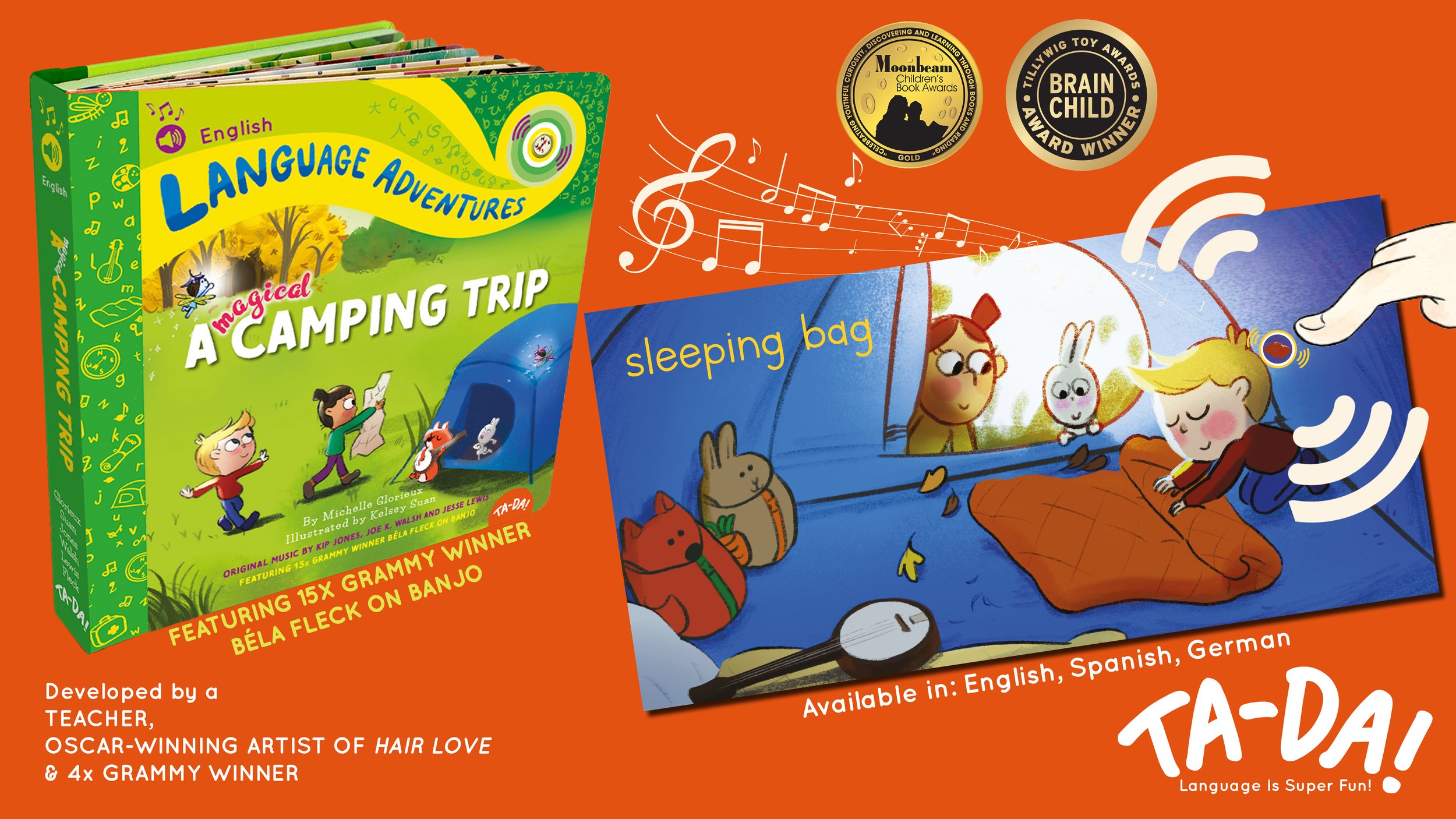
Why TA-DA! Talking Books?
Multi-Sensory Learning: Combines touch, sound, sight - and MUSIC - for an unmatched, immersive experience.
Eco-Friendly: Made with forest-friendly paper and child-safe materials.
Fine Motor Skills: Interactive buttons boost confidence and motor skills.
Real Voices: Authentic pronunciations by native speakers from around the world.
Award-Winning Team: Created by language experts alongside leading musical talent, including the acclaimed producers of Yo-Yo Ma, Lady Gaga, Beyonce, Shakira and 15x Grammy award-winning Béla Fleck!
TA-DA! Makes It Irresistibly Fun!

#tadalanguages
Don’t forget to include us in on the fun!
Whether it's photos, videos, art or your own music, we can't wait to see what you create! Plus, you might just be selected for a special treat as part of a TA-DA! feature!


